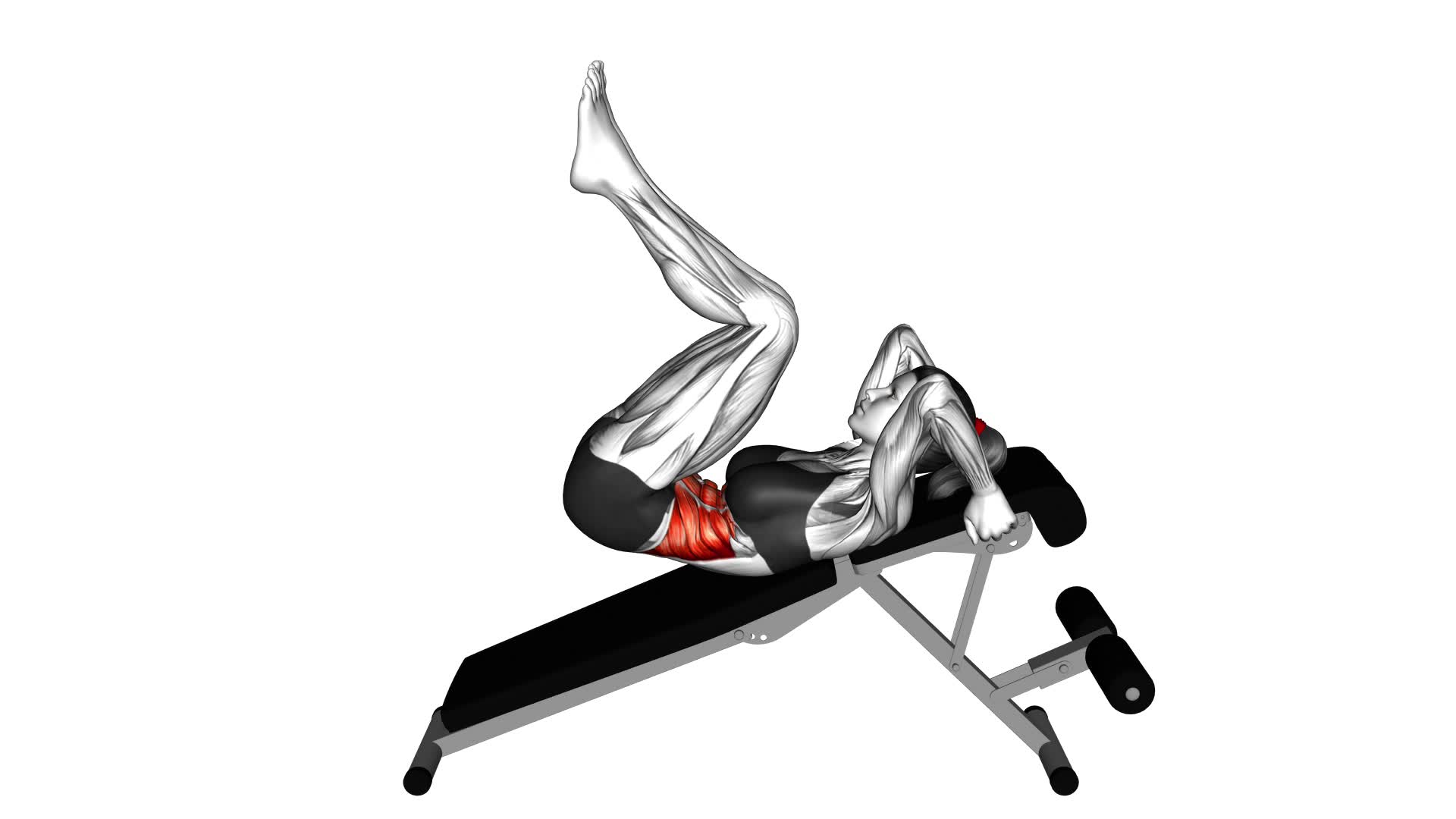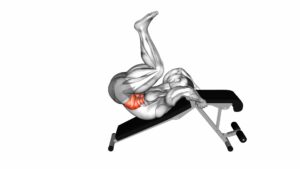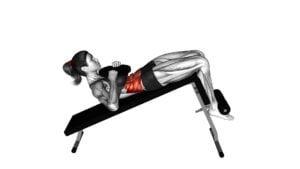Decline Bent Leg Reverse Crunch (female) – Video Exercise Guide & Tips

Are you looking for a challenging core exercise that targets your lower abs? Look no further than the decline bent leg reverse crunch.
Watch This Exercise Video
In this video exercise guide, we'll show you the proper form and technique for this effective move. Whether you're a beginner or advanced, we've got modifications and progressions to suit all fitness levels.
Avoid common mistakes and maximize your results with our helpful tips.
Let's get those abs burning!
Key Takeaways
- The Decline Bent Leg Reverse Crunch is performed on a decline bench with knees bent and feet secured.
- Proper form and technique include lifting the hips off the bench, curling the knees towards the chest, and maintaining control without swinging or jerking motions.
- The exercise strengthens core muscles, improves posture, balance, and athletic performance, and targets the lower abs for a toned and defined midsection.
- Progression and variations can be achieved by mastering the basic movement, exploring different angles, straightening the legs for added difficulty, and trying alternative exercises like the Decline Reverse Crunch or Hanging Leg Raise.
Benefits of the Decline Bent Leg Reverse Crunch
Discover the numerous benefits you can achieve by incorporating the Decline Bent Leg Reverse Crunch into your fitness routine. One of the key benefits of this exercise is its ability to strengthen your core muscles. Core strength is crucial for overall fitness as it provides stability and support for your entire body. By targeting your abs, obliques, and lower back muscles, the Decline Bent Leg Reverse Crunch helps to improve your posture, balance, and overall athletic performance.
Incorporating the Decline Bent Leg Reverse Crunch into a full body workout routine is also highly effective. This exercise engages multiple muscle groups, making it a great addition to any comprehensive workout plan. It can be performed as a standalone exercise or integrated into a circuit training routine.
To incorporate it into your full body workout, start by lying on a decline bench with your knees bent and feet secured. Place your hands behind your head and engage your core. Slowly lift your hips off the bench while curling your knees towards your chest. Lower your hips back down and repeat for the desired number of repetitions.
Proper Form and Technique for the Exercise
To perform the Decline Bent Leg Reverse Crunch with proper form and technique, you should start by lying on a decline bench with your knees bent and feet secured. Place your hands behind your head, keeping your elbows out to the sides.
Begin the movement by lifting your hips off the bench and curling your knees towards your chest. As you do this, contract your abs and exhale. Hold the peak contraction for a moment, then slowly lower your hips back down to the starting position, inhaling as you do so.
It is important to maintain control throughout the exercise, avoiding any swinging or jerking motions. This will ensure that you're effectively targeting your abs and minimizing the risk of injury. Additionally, keep your core engaged throughout the movement, focusing on using your abdominal muscles to lift your hips rather than relying on momentum.
Common errors to watch out for include using your neck or shoulders to lift your upper body instead of your abs, and not fully extending your legs at the bottom of the movement. Remember to keep your movements smooth and controlled, and avoid any excessive strain on your neck or lower back.
Variations of the Decline Bent Leg Reverse Crunch can include straightening your legs instead of keeping them bent, or adding a twist at the top of the movement to engage your obliques. However, ensure you have mastered the basic form and technique before attempting these variations.
Modifications and Progressions for All Fitness Levels
Continue building strength and challenging your abs by incorporating modifications and progressions into your Decline Bent Leg Reverse Crunch routine. These modifications allow you to tailor the exercise to your current fitness level and gradually increase the difficulty as you get stronger.
If you're a beginner, you can start by performing the exercise on a flat bench instead of a decline bench. This will reduce the intensity and make it more manageable for you. As you become more comfortable, you can gradually increase the decline of the bench to increase the challenge.
Another modification you can try is placing your hands behind your head instead of by your sides. This will engage your core muscles even more and intensify the exercise. If you want to further challenge yourself, you can add a weight plate or a dumbbell between your feet while performing the reverse crunch. This will increase the resistance and make the exercise more demanding for your abs.
Remember to listen to your body and only progress to the next level when you feel ready. Pushing yourself too hard too soon can lead to injuries.
Now that you know how to modify the exercise, let's move on to the next section where we'll discuss common mistakes to avoid when performing the Decline Bent Leg Reverse Crunch.
Common Mistakes to Avoid When Performing the Exercise
When performing the Decline Bent Leg Reverse Crunch, it's important to be aware of common mistakes to avoid in order to maximize the effectiveness of the exercise and prevent injury. Here are some technique tips to keep in mind:
- Using momentum: Avoid swinging your legs or using momentum to lift them up. This reduces the effectiveness of the exercise and can strain your lower back. Focus on using your abdominal muscles to lift your legs and maintain control throughout the movement.
- Lifting your hips too high: It's important to lift your hips off the bench, but avoid lifting them too high. This can put excessive strain on your lower back and compromise your form. Lift your hips just enough to engage your abs and maintain a neutral spine.
- Not engaging your core: The key to this exercise is engaging your core muscles. Make sure to contract your abs and focus on using them to lift your legs. Avoid relying on your hip flexors or other muscles to perform the movement.
- Not maintaining proper form: Keep your lower back pressed against the bench throughout the exercise. This helps to protect your spine and ensures that you're targeting your abs effectively. Avoid arching your back or letting it round during the movement.
Tips for Maximizing the Effectiveness of the Decline Bent Leg Reverse Crunch
To maximize the effectiveness of the Decline Bent Leg Reverse Crunch, focus on engaging your core muscles and maintaining proper form throughout the exercise. This will help you achieve the best results and avoid potential injuries.
Here are some tips to help you get the most out of this exercise:
- Engage your core: Before you start the exercise, consciously engage your core muscles by pulling your belly button towards your spine. This will activate your abdominal muscles and ensure they're properly targeted during the movement.
- Use controlled movements: Avoid using momentum to lift your legs. Instead, use slow and controlled movements to fully engage your abdominal muscles. This will maximize the effectiveness of the exercise and prevent strain on your lower back.
- Maintain proper form: Keep your lower back pressed into the bench throughout the movement. This will help prevent excessive strain on your spine and ensure that your abdominal muscles are doing the work.
- Try variations and alternatives: Once you have mastered the basic Decline Bent Leg Reverse Crunch, you can try different variations to target your core from different angles. For example, you can try straightening your legs or adding a twist to the movement. Alternatively, you can explore alternative exercises such as the Decline Reverse Crunch or the Hanging Leg Raise to further challenge your core muscles.
Frequently Asked Questions
How Many Calories Does the Decline Bent Leg Reverse Crunch Burn?
The decline bent leg reverse crunch is an effective exercise for targeting your lower abs. When performed with proper form and technique, it can help you burn calories and strengthen your core.
Is the Decline Bent Leg Reverse Crunch Suitable for Pregnant Women?
During pregnancy, it's important to focus on pregnancy-safe core exercises and make modifications to your abdominal workouts.
When considering the decline bent leg reverse crunch, it's crucial to consult with your healthcare provider. They can provide guidance on whether this exercise is suitable for you and recommend alternatives or modifications if needed.
Always prioritize the safety and comfort of you and your baby when choosing exercises during pregnancy.
Can the Decline Bent Leg Reverse Crunch Help Reduce Lower Back Pain?
Yes, decline bent leg reverse crunches can help reduce lower back pain. By targeting the abdominal muscles and strengthening the core, these exercises can provide stability and support to the lower back, alleviating pain.
However, it's important to note that other exercises can also be effective in reducing lower back pain. Incorporating exercises that focus on stretching and strengthening the back muscles, such as cat-camel stretches and bird dogs, can complement the decline bent leg reverse crunches for optimal results.
How Often Should the Decline Bent Leg Reverse Crunch Be Performed for Optimal Results?
To achieve optimal results with the decline bent leg reverse crunch, you need to consider frequency.
How often should you perform this exercise? Well, for maximum effectiveness, it's recommended to do it 2-3 times per week.
This allows your muscles ample time to recover and grow stronger.
Are There Any Alternatives to the Decline Bent Leg Reverse Crunch for Targeting the Same Muscle Group?
Looking for alternatives to target the same muscle group as the decline bent leg reverse crunch?
Try hanging leg raises and seated knee tucks. These exercises can provide similar benefits and help strengthen your core.
Hanging leg raises involve hanging from a bar and lifting your legs, while seated knee tucks are performed while sitting on a bench and bringing your knees towards your chest.
Give these alternatives a try and see which one works best for you!
Conclusion
In conclusion, the decline bent leg reverse crunch is a beneficial exercise for strengthening the abdominal muscles. By maintaining proper form and technique, individuals can effectively target their core and improve overall fitness.
Modifications and progressions allow for customization to different fitness levels, while avoiding common mistakes ensures safety and effectiveness. By following these tips, individuals can maximize the effectiveness of this exercise and achieve their fitness goals.

Author
Years ago, the spark of my life’s passion ignited in my mind the moment I stepped into the local gym for the first time. The inaugural bead of perspiration, the initial endeavor, the very first surge of endorphins, and a sense of pride that washed over me post-workout marked the beginning of my deep-seated interest in strength sports, fitness, and sports nutrition. This very curiosity blossomed rapidly into a profound fascination, propelling me to earn a Master’s degree in Physical Education from the Academy of Physical Education in Krakow, followed by a Sports Manager diploma from the Jagiellonian University. My journey of growth led me to gain more specialized qualifications, such as being a certified personal trainer with a focus on sports dietetics, a lifeguard, and an instructor for wellness and corrective gymnastics. Theoretical knowledge paired seamlessly with practical experience, reinforcing my belief that the transformation of individuals under my guidance was also a reflection of my personal growth. This belief holds true even today. Each day, I strive to push the boundaries and explore new realms. These realms gently elevate me to greater heights. The unique combination of passion for my field and the continuous quest for growth fuels my drive to break new ground.







